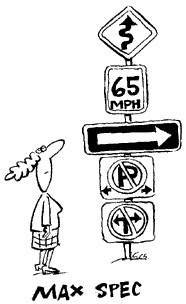
Provide minimum specifications, rather than trying to plan every little detail.
Tales
Emerges from fabric
Worldwide complexity
Make it or let it
Bibliography
Morgan:
Images
Stacey:
Unknowable
Waldrop:
Trillion
Since the behavior
of a CAS emerges from the interaction among the agents, and since the
detailed behavior of the system is fundamentally unpredictable, it does
little good to spend all the time that most organizations spend in detailed
planning. Most organizational leaders have participated in very detailed
planning, only to find that assumptions and inputs must be changed almost
immediately after the plan is finalized. Complexity science suggests that
we would be better off with minimum specifications and general senses
of direction, and then allow appropriate autonomy for individuals to self-organize
and adapt as time goes by. The science behind this principle traces it
roots back to a computer simulation called “Boids,” developed
in 1987 by Craig
Reynolds. The simulation consists of a collection of autonomous agents
– the boids – in a environment with obstacles. In addition to
the basic laws of physics, each agent follows three simple rules: (1)
try to maintain a minimum distance from all other boids and objects; (2)
try to match speed with neighboring boids; and, (3) try to move toward
the center of mass of the boids in your neighborhood. Remarkably, when
the simulation is run, the boids exhibit the very lifelike behavior of
flying in flocks around the objects on the screen. They flock, a complex
behavior pattern, even though there is no rule explicitly telling them
to do so. While this does not prove that birds actually use these simple
rules, it does show that simple rules – minimum specifications –
can lead to complex behaviors. These complex behaviors emerge from the
interactions among agents, rather than being imposed upon the CAS by an
outside agent or an explicit, detailed description.
"The principle of min specs [minimum
specifications] suggests that managers should define no more than is absolutely necessary
to launch a particular initiative or activity on its way. They have to avoid the role of
‘grand designer’ in favor of one that focuses on facilitation, orchestration and
boundary management, creating ‘enabling conditions’ that allow a system to find
its own form." |
 In
contrast, we often over-specify things when designing or planning new activities in our
organizations. This follows from the paradigm of “organization as a machine.” If
you are designing a machine, you had better think of everything, because the machine
cannot think for itself. Of course, in some cases, organizations do act enough like
machines to justify selected use of this metaphor. For example, if you are having your
gall bladder removed, you’d like the surgical team to operate as a precision machine;
save that emerging, creative behavior for another time! Maximum specifications and the
elimination of variation might be appropriate in such situations.
In
contrast, we often over-specify things when designing or planning new activities in our
organizations. This follows from the paradigm of “organization as a machine.” If
you are designing a machine, you had better think of everything, because the machine
cannot think for itself. Of course, in some cases, organizations do act enough like
machines to justify selected use of this metaphor. For example, if you are having your
gall bladder removed, you’d like the surgical team to operate as a precision machine;
save that emerging, creative behavior for another time! Maximum specifications and the
elimination of variation might be appropriate in such situations.
Most of the time, however,
organizations are not machine-like; they are complex adaptive systems. The key learning
from the simulations is that in the case of a CAS, minimum specifications and purposeful
variation are the way to go.
This principle would suggest,
for example, that intricate strategic plans be replaced by simple documents that describe
the general direction the organization is pursuing and a few basic principles for how the
organization should get there. The rest is left to the flexibility, adaptability and
creativity of the system as the context continually changes. This, of course, is a
frightening thought for leaders classically trained in the machine and military metaphors.
But the key questions are: Are these traditional metaphors working for us today? Are we
able to lay out detailed plans and then just do it with a guaranteed outcome? If not, do
we really think that planning harder will be any better?
 The quintessential organizational
example of this principle of good-enough vision and minimum specifications
is the credit-card company, Visa International. Despite its $1 trillion
annual sales volume and roughly half-billion clients, few people could
tell you where it is headquartered or how it is governed. It’s founding
chief executive officer, Dee Hock describes it as a nonstock, for-profit
membership corporation in which members (typically, banks that issue the
Visa cards) cooperate intensely “in a narrow band of activity essential
to the success of the whole” (for example, the graphic layout of
the card and common clearinghouse operations), while competing fiercely
and innovatively in all else (including going after each other’s
customers!). This blend of minimum specifications in the essential areas
of cooperation, and complete freedom for creative energy in all else,
has allowed Visa to grow 10,000 percent since 1970, despite the incredibly
complex worldwide system of different currencies, customs, legal systems
and the like. “It was beyond the power of reason to design an organization
to deal with such complexity,” Hock explained. “The organization
had to be based on biological concepts to evolve, in effect, to invent
and organize itself.”
The quintessential organizational
example of this principle of good-enough vision and minimum specifications
is the credit-card company, Visa International. Despite its $1 trillion
annual sales volume and roughly half-billion clients, few people could
tell you where it is headquartered or how it is governed. It’s founding
chief executive officer, Dee Hock describes it as a nonstock, for-profit
membership corporation in which members (typically, banks that issue the
Visa cards) cooperate intensely “in a narrow band of activity essential
to the success of the whole” (for example, the graphic layout of
the card and common clearinghouse operations), while competing fiercely
and innovatively in all else (including going after each other’s
customers!). This blend of minimum specifications in the essential areas
of cooperation, and complete freedom for creative energy in all else,
has allowed Visa to grow 10,000 percent since 1970, despite the incredibly
complex worldwide system of different currencies, customs, legal systems
and the like. “It was beyond the power of reason to design an organization
to deal with such complexity,” Hock explained. “The organization
had to be based on biological concepts to evolve, in effect, to invent
and organize itself.”
"Managers therefore cannot form a vision
of some future state toward which the business can be moved; the futures open to the
system are too many, and the links between a future and the actions leading to it are too
obscure. Chaotic dynamics lead us to see strategy as a direction into the future that
emerges from what managers do. In chaotic conditions, strategy cannot be driven by pure
intentions. Instead, it represents the unintentional creation of order out of chaos." |
Next | Previous | Return to Contents List
All Components of Edgeware
Principles Copyright © 2001, Curt
Lindberg, Complexity Management, VHA Inc. Permission to copy for educational
purposes only. All other rights reserved.